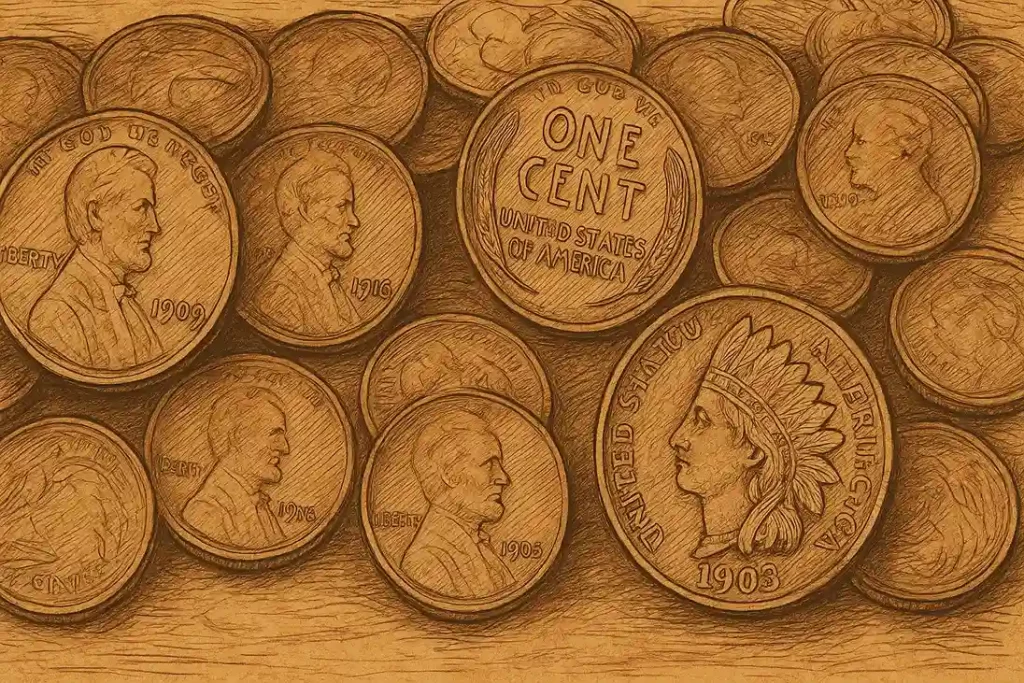
Health Article
How to Detect a Valuable Penny in Your Collection: Guide for Hobbyists
On May 6, 2025 by StyleGuide
At first glance, a penny may seem like the least exciting coin in your pocket — a humble piece of copper (or zinc) often overlooked or tossed into a change jar. But for collectors, pennies represent an entire world of history, artistry, and potential value. Some pennies, due to their rarity or errors, have sold for thousands of dollars. Even the relatively new 1968 penny value sometimes rises to $3,000!
Penny collecting, or cent numismatics, offers hobbyists of all ages an affordable and rewarding gateway into the broader world of coin collecting. Unlike silver dollars or ancient coins, pennies are accessible — they show up in circulation, are easy to store, and are packed with detail that reveals everything from historical events to minting quirks.
This guide isn’t just for those with decades of experience. Whether you’ve inherited a jar of old coins, found a wheat penny in your change, or want to build a collection from scratch, knowing what makes a penny valuable is essential to uncovering the hidden treasures in your stash.

Key Factors That Determine Penny Value
Not all old pennies are worth money, and not all shiny ones are worthless. Understanding what drives a penny’s value helps you make informed decisions and avoid overlooking a true gem. The four core factors to consider are:
Condition (Grade)
Condition is king. The better the coin’s preservation, the more it can be worth. Coin grading is a standardized system that evaluates wear, detail, and luster. Here’s a simplified breakdown:
| Grade Name | Description |
| Good (G) | Heavily worn, details mostly flat |
| Fine (F) | Moderate wear, design details visible |
| Very Fine (VF) | Light to moderate wear, sharp details |
| Extremely Fine (EF/XF) | Minimal wear, strong detail |
| About Uncirculated (AU) | Slight wear on highest points |
| Mint State (MS) | No wear, as it left the mint – pristine |
Even two identical coins can differ wildly in value based solely on their grade. For example, a 1909-S VDB penny in Good condition may be worth around $700, while the same coin in Mint State could command $5,000 or more.
Key Dates and Mint Marks
Certain years are especially prized due to low mintage numbers or historical significance. Pair those with mint marks, and you might have a serious find.
Here’s a quick cheat sheet of key penny dates to watch for:
| Type | Key Dates & Mint Marks |
| Lincoln Wheat Cents (1909–1958) | 1909-S VDB, 1914-D, 1922 No D, 1931-S |
| Indian Head Cents (1859–1909) | 1877, 1908-S, 1909-S |
| Flying Eagle Cents (1856–1858) | 1856 (rare pattern coin), 1858 large letters |
Mint marks indicate where the coin was made and can be found just below the year on the obverse (heads side). Common marks include:
- D = Denver
- S = San Francisco
- (No mint mark) = Philadelphia
Certain combinations, like a 1914-D (Denver), are incredibly rare and command high prices.
Errors and Varieties
Minting mistakes turn ordinary coins into highly sought-after collectibles. These errors aren’t just flaws — they’re often unique signatures of a moment in minting history.
Types of Errors to Look For:
- Double Die Obverse (DDO): Design elements, especially the date or lettering, appear doubled.
- Off-Center Strike: The design is not centered; more dramatic off-centers are more valuable.
- Clipped Planchets: A piece of the coin is missing due to a miscut blank.
- Missing Mint Marks: Particularly on coins where a mark was expected.
Famous example: The 1955 Double Die Lincoln cent is one of the most famous errors. In fine condition, it can fetch $1,000–$2,500 or more.
Bonus Tip: Color and Luster
Copper reacts over time, changing in color depending on exposure. The hobby recognizes three main color classifications, particularly for Lincoln cents:
| Color Grade | Meaning |
| Red (RD) | Original copper luster, untouched by oxidation |
| Red-Brown (RB) | Partial toning, some luster remains |
| Brown (BN) | Fully toned or oxidized |
Red pennies in higher grades are more desirable and valuable. For example, an MS65 Red 1931-S Wheat penny might be worth several times more than its brown counterpart.
Essential Tools and Resources for Penny Identification
You don’t need a professional numismatist’s lab to evaluate your coin collection. However, using the right tools and references can make a huge difference in accuracy and speed. Whether you’re digging through pocket change or examining an inherited coin jar, the following items are must-haves in any collector’s toolkit.
📱 Mobile Apps: Coin Identification Made Easy
Technology has made coin collecting easier than ever. With a smartphone and the right app, you can identify coins instantly, check current values, and even organize your collection.
Recommended App: Coin ID Scanner
This app allows you to scan coins using your phone’s camera. It identifies coin types, provides mintage year and mint mark data, and estimates current value based on condition. It’s a game-changer for beginners and pros alike — especially when going through large volumes of coins.
| App Feature | Benefit |
| Instant coin ID | No need to guess or flip through guides |
| Value estimation | See market value based on grading levels |
| Error recognition | Helps flag known error types and varieties |
| Collection tracker | Organize and log your coins efficiently |

🔍 Magnification: See What the Naked Eye Can’t
Many valuable features — from subtle die errors to mint marks — are too small to detect without assistance. A 10x jeweler’s loupe or a high-quality magnifying glass is the gold standard. For serious collectors, digital microscopes that connect to a smartphone or PC can provide detailed close-ups and even allow you to take and compare photos.
Pro Tip: Look at the edges and lettering under magnification. Doubled elements, tiny nicks, or flaws in the strike can hint at rare errors.
📚 Reference Guides and Websites
Knowledge is power in numismatics. Keep these resources close by:
- CoinValueChecker.com: This site provides real-time valuations, a breakdown of coin types, and error varieties. Great for quick checks on date and mint mark combinations.
- American Numismatic Association (money.org): Offers educational materials, certification info, and a trusted coin grading scale.
- CoinWeek, Numismatic News, and The Westminster Collection Blog: These top coin blogs deliver up-to-date market trends, auction results, and interviews with experts.
Staying informed means you can react quickly to changes in demand or spot opportunities others may miss.
Step-by-Step: How to Spot a Valuable Penny
Once you’re equipped with tools and references, it’s time to begin the search. Here’s a step-by-step approach to analyzing your collection like a seasoned hobbyist:
Step 1: Sort Your Pennies by Type and Design
Start with basic organization. Group your coins by their reverse design:
- Lincoln Wheat Cent (1909–1958)
- Lincoln Memorial Cent (1959–2008)
- Indian Head Cent (1859–1909)
- Flying Eagle Cent (1856–1858)
- Shield Cent (2010–present)
Sorting by type helps you quickly zero in on series that are known to contain rare issues.
Step 2: Examine Dates and Mint Marks
Use your reference guide or the Coin ID Scanner app to identify any key dates or low-mintage years. Pay special attention to:
- Mint mark location (typically under the year)
- Odd spacing or size inconsistencies in lettering
- Missing or doubled mint marks (a sign of possible errors)
Key Tip: A 1922-D Lincoln Wheat penny with a missing “D” mint mark (known as the 1922 No D) is a rare and highly valuable error.
Step 3: Inspect for Errors and Varieties
Use your magnifying tool to scan for:
- Double die obverse: Look closely at the date and lettering.
- Die cracks: Tiny raised lines on the coin from worn dies.
- Clipped planchets: Crescent-shaped cuts on the coin’s edge.
- Off-center strikes: Design is misaligned on the planchet.
Mark any suspicious or unusual coins and compare them with online error image databases or submit them for professional evaluation.
Step 4: Grade the Condition
Use a grading chart or reference images to determine wear and luster. Look for:
- Full lines in Lincoln’s coat or the wheat ears (on Wheat Cents)
- High point details like the cheekbone or hair curls
- Original red color and lack of spots or corrosion
If in doubt, compare the coin to certified graded examples online.
Step 5: Use Digital Tools for Final Confirmation
Scan the coin with Coin ID Scanner to confirm your findings. This acts as a cross-check and can give additional insight, especially on modern varieties and lesser-known errors.
Step 6: Check Values and Compare
With identification and condition in hand, cross-reference value guides like CoinValueChecker.com to get a realistic sense of worth. Prices can vary depending on market demand, but checking completed auction listings can also give insight into what buyers are willing to pay.
Protecting and Storing Your Valuable Pennies
Once you’ve identified valuable or potentially rare pennies in your collection, proper preservation becomes essential. Mishandling, moisture, and even your fingers can degrade a coin’s condition and diminish its value. Here are the best practices to protect your collection:
🧤 Handle With Care
Always handle coins by the edges and preferably while wearing cotton gloves. The oils and acids from bare skin can react with metal surfaces, especially on high-grade copper coins, leaving permanent fingerprints or spots.
🧴 Avoid Cleaning Your Coins
This is a common mistake among beginners. Cleaning — even gently with soap or a cloth — can significantly reduce a coin’s value, particularly if it scratches the surface or removes original patina. Collectors and dealers prefer natural aging, even if it includes light toning.
📦 Use Professional Storage Solutions
Protecting coins from environmental damage will maintain their quality and long-term value. Consider:
- Coin Capsules: Air-tight plastic holders ideal for valuable or rare coins.
- 2×2 Holders: Cardboard holders with a mylar window. Great for organization and labeling.
- Coin Albums: Best for series collecting (e.g., Lincoln cents from 1909 to present).
- Archival Boxes: Store coins in a climate-controlled container away from humidity, dust, and direct sunlight.
Ideal Conditions:
Keep your collection in a cool, dry space. Avoid basements or attics where temperature and humidity fluctuate. Use silica gel packets in your storage area to absorb moisture and prevent corrosion.
Where to Learn More and Build Authority
Coin collecting is a lifelong journey. As you grow your collection and expertise, connecting with reliable resources and communities is key. Whether you’re researching new additions or planning to sell high-value coins, these platforms offer trusted knowledge and support:
📲 Use Technology to Stay Ahead
The Coin ID Scanner app continues to be a reliable ally for hobbyists. With the ability to scan, assess, and catalog coins directly from your mobile device, it streamlines the research process, especially when dealing with large collections or new acquisitions.
Use Coin ID Scanner to:
- Instantly identify coins by year and mint mark
- Flag errors or rare varieties automatically
- Maintain a digital inventory with photos and notes
- Get updated market value estimates based on condition
🧠 Reputable Educational Resources
- CoinValueChecker.com: A go-to resource for checking penny values, identifying rare errors, and comparing coin grades.
- American Numismatic Association (ANA): Join to access in-depth numismatic education, certification programs, and exclusive collector events.
- PCGS Photograde: Compare your coins with professionally graded examples to better understand condition and value.
📰 Stay Updated With Expert Blogs
- CoinWeek: Industry news, featured auctions, and expert interviews.
- The Westminster Collection Blog: Insightful posts on British and American coinage, perfect for thematic collectors.
- Numismatic News: Tracks market shifts, coin law changes, and collector alerts.
Penny collecting is more than a pastime — it’s a blend of history, art, and detective work. Each coin in your pocket change or old drawer could carry a story worth telling… or worth hundreds (even thousands) of dollars. But the real treasure is the experience of searching, learning, and connecting with a community of like-minded enthusiasts.
Whether you find a rare 1909-S VDB Wheat penny or simply enjoy assembling a full year set, the thrill of the hunt is real — and always just one coin away.
- How to Detect a Valuable Penny in Your Collection: Guide for HobbyistsAt first glance, a penny may seem like the least exciting coin in your pocket — a humble piece of copper (or zinc) often overlooked
- Organizing a Family Trip without Going Crazy: Top Life HacksPlanning a family trip should spark excitement, not migraines. But when you’re juggling different interests, dietary needs, nap schedules, finding out ‘does GPS work without
- Go Vintage: Top Tips on Flea Markets ExplorationFlea markets are more than just open-air bazaars—they’re living archives of style, craftsmanship, and stories waiting to be uncovered. Whether you’re searching for a mid-century
- The Power of Accessories: Elevating Every OutfitIn the world of fashion, accessories play a pivotal role in transforming an outfit from ordinary to extraordinary. They have the power to convey your
- Offbeat Destinations: Discovering the World’s Hidden GemsIntroduction In a world where popular tourist hotspots often dominate travel itineraries, there is a growing desire among adventurous souls to explore the lesser-known destinations
- Unraveling the Mysteries Behind Celebrity Beauty SecretsUnraveling the Mysteries Behind Celebrity Beauty Secrets The allure of celebrities is undeniable – from their stunning good looks to their seemingly ageless appearances. Many












